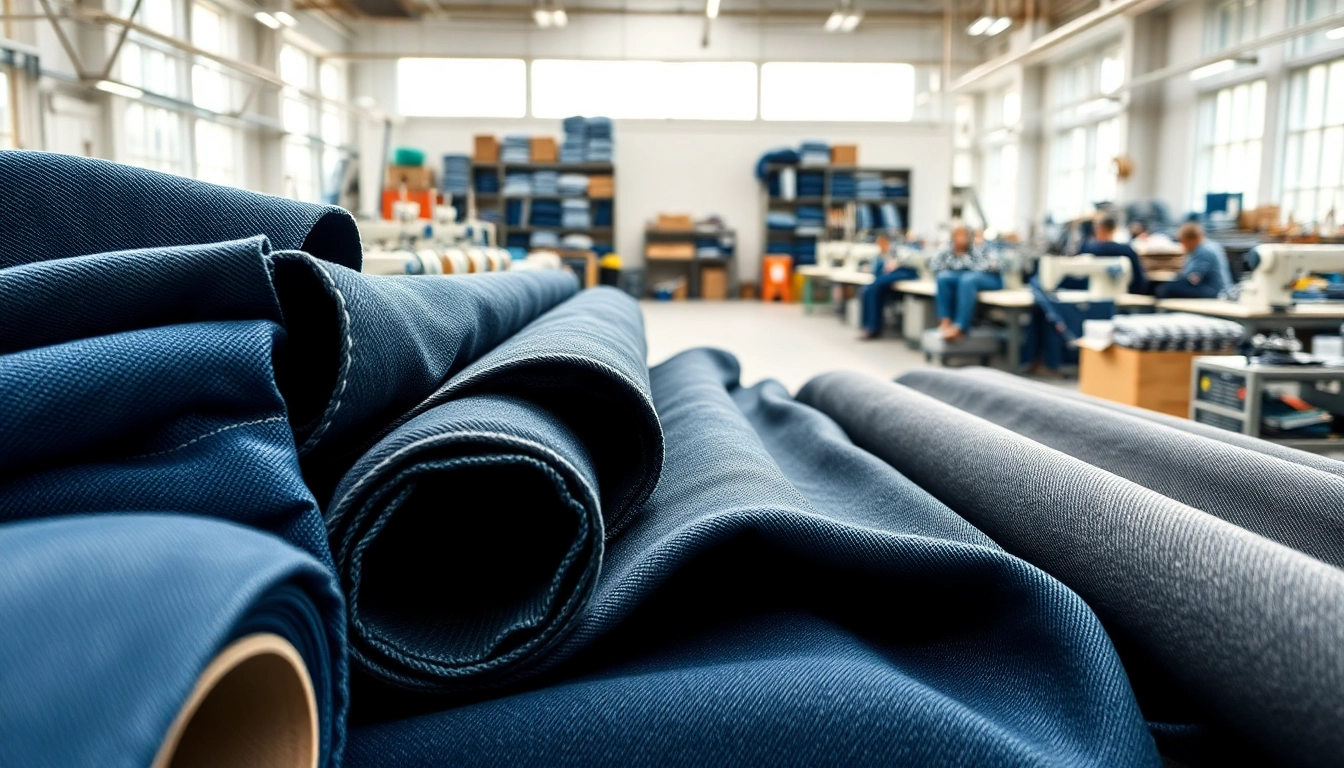Understanding the Role of Jeans Fabric Manufacturers
Jeans fabric manufacturers play a pivotal role in the global textile industry, providing the base material for one of the most beloved garments: denim jeans. The importance of understanding denim production roots not only in appreciating the fabric’s history but also in recognizing the intricate processes that contribute to its quality and sustainability. As consumers increasingly prioritize eco-friendly practices, the significance of sourcing becomes paramount. To delve deeper into this fabric’s production, one must understand the historical context, the defining characteristics of high-quality denim, and the sustainable practices that are shaping the industry today. Aside from fulfilling consumer demand, these jeans fabric manufacturers are instrumental in navigating innovations and challenges in the market.
Historical Context of Denim Fabric Production
The journey of denim fabric dates back to the 17th century when it originated in France, known as “serge de Nîmes.” This durable fabric was initially woven with cotton and wool, later evolving to comprise predominantly cotton threads. By the mid-19th century, denim gained popularity in America, particularly during the Gold Rush, when durable workwear was in high demand. It was during this time that the iconic blue jean was patented by Levi Strauss and Jacob Davis, introducing riveted jeans for miners and laborers.
This rich history is instrumental in understanding the evolution of jeans fabric and the enduring appeal that has transformed denim into a fashion staple worldwide. Jeans today represent more than just a functional outfit; they symbolize casual style, cultural identity, and sustainable fashion initiatives that have grown over recent decades.
Key Characteristics of High-Quality Denim
When discerning high-quality denim, several attributes come into play:
- Fiber Composition: Denim is primarily made from cotton, with variations like selvedge and stretch denim utilizing a percentage of elastic fibers like spandex for comfort.
- Weight: The weight of denim, measured in ounces per square yard, can influence not only the feel but also the durability of the fabric, with heavier denims often being sturdier.
- Finish: The treatment a fabric undergoes enhances its appearance and functionality. Finishes can range from sanforized (pre-shrunk) to chemical washes that add aesthetic appeal.
- Twill Weave: The classic twill weave creates the identifiable diagonal ribbing on the fabric, providing strength and making it more visually interesting.
Each of these characteristics contributes to the overall quality and finish of denim, allowing manufacturers to cater to various market segments, from high-end designer brands to mass-market offerings.
Understanding Sustainable Practices in Denim Manufacturing
The environmental impact of denim production has propelled sustainable manufacturing practices into the spotlight. Traditionally, denim production has been criticized for its heavy resource consumption, particularly water and chemicals utilized in dyeing and finishing. Today, leading jeans fabric manufacturers are pivoting towards more sustainable practices including:
- Water Management: Techniques such as waterless dyeing and recycled water systems significantly reduce overall water consumption.
- Natural Dyes: Utilizing organic dyes and non-toxic chemicals help minimize environmental pollution and reduce the carbon footprint.
- Ethical Sourcing: Sourcing materials from GOTS (Global Organic Textile Standard) certified suppliers ensures high environmental and social responsibility standards throughout the supply chain.
- Recycling Initiatives: Many manufacturers are adopting circular economy practices, turning old denim into new fabric or other products, thus reducing waste.
By embracing sustainability, manufacturers not only meet consumer demands for eco-friendly options but also help mitigate the adverse impacts of traditional denim production.
Choosing the Right Jeans Fabric for Your Needs
Evaluating Fabric Types and Weaves
The first step in selecting denim fabric is understanding the various types and weaves available. While the traditional denim weave comprises two different yarns, there are several fabric types, including:
- Cotton Denim: The most common type, used for standard jeans and often blended with other fibers for increased stretch.
- Stretch Denim: Incorporates elastic fibers, allowing for greater comfort and fit.
- Selvedge Denim: Known for its tightly woven edges which prevent fraying, it’s often considered higher quality due to manual loom production.
- Corduroy Denim: A textured fabric made from a twill weave that offers a unique visual and tactile experience.
Evaluating the intended use of the denim—be it for high-fashion, casual wear, or workwear—will guide the decision-making process in fabric selection.
Determining the Best Denim Weight for Your Projects
Denim weight varies widely, typically ranging from 6 to 32 ounces. Lighter weights provide comfort and fluidity, suitable for casual settings, while heavier weights offer durability, perfect for workwear or structured garments. The balance between comfort and durability needs to be assessed based on the end use:
- Lightweight (6-10 oz): Ideal for summer garments, offering breathability and ease of movement.
- Midweight (11-14 oz): A versatile choice for everyday jeans, combining comfort with some durability.
- Heavyweight (15+ oz): Typically used for heavy-duty work jeans, ensuring long-lasting wear and resistance to wear.
The weight of the fabric directly impacts its performance and feel, making this a critical consideration during the selection process.
How Finishes Can Enhance Denim’s Appeal
The finishing process is where denim is brought to life. Various finishes can vastly enhance the aesthetic and functional qualities of the fabric:
- Stone Washing: This technique softens the fabric, creating a worn-in look.
- Acid Washing: Offers a unique faded appearance with a contemporary edge.
- Sanding: Creates a smooth texture while giving denim a distressed look.
- Waxed Finishes: Introduces water resistance and a distinctive sheen, ideal for fashion-forward pieces.
These finishes can transform the fabric’s appearance, adding layers of complexity that appeal to diverse consumer preferences.
Innovations in Denim Manufacturing
Advanced Production Techniques in the Jeans Fabric Industry
Innovation drives progress in the denim industry. Several advanced production techniques have emerged to increase efficiency and enhance fabric quality:
- Laser Technology: Laser cutting and finishing reduce the need for water and chemicals, promoting sustainability.
- 3D Weaving: Innovative methods allow for intricate patterns and shapes in denim production that provide unique aesthetic qualities.
- Digital Printing: This provides unparalleled design versatility, enabling intricate graphics and patterns to be applied to denim easily.
The adoption of these technologies reflects a trend toward greater efficiency and creativity in denim fabric production, encouraging both manufacturers and designers to push the boundaries of what denim can achieve.
The Impact of Technology on Fabric Design
Technology has revolutionized how denim is designed and produced. New software tools and collaborative platforms allow manufacturers to streamline their processes:
- CAD (Computer-Aided Design): Facilitates precise fabric design, enabling manufacturers to visualize and tweak patterns digitally.
- Virtual Prototyping: Reduces waste and production costs by allowing designers to create and approve samples in a virtual environment before physical production.
- Supply Chain Technologies: Innovations in tracking and logistics ensure timely delivery of materials and a more transparent supply chain.
These technological advancements not only improve production efficiency but also contribute to a more sustainable approach to fabric design and manufacturing.
Future Trends in Denim Sustainability
The future of denim lies in sustainable practices that align with consumer expectations for ethical consumption. Emerging trends shaping this future include:
- Bio-Denim: Development of denim made from natural fibers and biodegradable components to reduce environmental impact.
- Closed Loop Systems: Emphasizing recycling and reuse, companies strive to implement practices that minimize waste.
- Transparency in Sourcing: The demand for ethically sourced materials is on the rise, prompting manufacturers to disclose their sourcing practices.
Manufacturers who adapt to these trends will not only future-proof their production methods but also enhance their brand equity in an increasingly conscious market.
Challenges Facing Jeans Fabric Manufacturers Today
Supply Chain Issues and Their Impact on Production
The denim industry is not immune to supply chain challenges. Global events, such as pandemics and trade disputes, can disrupt material availability and production timelines. Key issues manufacturers face include:
- Material Shortages: Fluctuating cotton prices and limited availability can hinder production capabilities.
- Shipping Delays: Global logistics challenges can lead to delays in sourcing materials and finalizing shipments.
- Quality Control: Maintaining quality standards across multiple suppliers poses ongoing challenges.
By adopting more localized sourcing strategies and fostering strong supplier partnerships, manufacturers can mitigate the effects of these supply chain disruptions.
Dealing with Changing Consumer Demands
As consumer trends evolve, so do the demands placed upon jeans fabric manufacturers. Increasingly, buyers are seeking customization, sustainability, and transparency. Manufacturers must respond by:
- Incorporating Customization Options: Offering tailored fabric selections and finishes can meet specific customer preferences.
- Emphasizing Sustainability: Transparency regarding production processes and eco-friendly materials is crucial in influencing consumer choices.
- Staying Agile: Manufacturers that can quickly adapt to changing trends are more likely to succeed in today’s dynamic market.
Responding proactively to consumer needs is essential for maintaining market relevance in an increasingly competitive landscape.
Quality Control Measures in Denim Manufacturing
Quality control is paramount in denim manufacturing. Maintaining consistency and high standards across the production process involves:
- Regular Inspections: Implementing consistent quality checks at various production stages ensures adherence to standards.
- Testing Fabric Performance: Assessing durability, colorfastness, and washability is essential to ensuring customer satisfaction.
- Supplier Audits: Establishing strong relationships and rigorous standards with suppliers is key to maintaining overall quality.
Implementing robust quality control measures not only aids in producing superior denim but also fosters trust with consumers who seek reliable products.
Connecting with Customers as Jeans Fabric Manufacturers
The Importance of Transparency in Fabric Sourcing
Today’s consumers are increasingly concerned about where and how the products they purchase are made. Transparency in sourcing and manufacturing practices is critical for building trust and credibility. Manufacturers can achieve this through:
- Traceability: Implementing systems to track materials from their origin to the finished product enhances consumer confidence.
- Open Communication: Providing regular updates and insights about production practices reinforces a brand’s commitment to integrity.
- Certifications: Obtaining certifications related to sustainability and ethical practices can bolster consumer trust.
Establishing transparency strengthens customer loyalty, vital in a competitive market focusing on ethical consumption.
Building Brand Loyalty through Quality Assurance
Quality assurance is a cornerstone of successful brand loyalty. When consumers consistently receive products that meet or exceed their expectations, they are more likely to return. Strategies to build loyalty include:
- Customer Feedback: Collecting and acting on customer feedback helps refine product offerings and identify improvement areas.
- Loyalty Programs: Implementing rewards for repeat customers encourages ongoing relationships.
- Educational Content: Offering resources about fabric care and styling can position brands as trusted authorities, enhancing customer trust and engagement.
When denim manufacturers prioritize quality, they foster repeat business and develop long-term relationships with consumers.
Effective Marketing Strategies for Denim Products
Effective marketing strategies are essential for standing out in a saturated denim market. Given the unique qualities of denim fabric, manufacturers can employ various approaches:
- Storytelling: Sharing the story behind the fabric, including its sourcing and production, can resonate deeply with consumers.
- Harnessing Social Media: Engaging consumers through visual platforms allows for showcasing products and connecting on a personal level.
- Collaborations: Partnering with influential designers or campaigns can enhance visibility and attract new customer demographics.
By employing innovative marketing strategies, manufacturers can effectively capture attention and drive sales in a competitive environment.



